A Private Tour today in North Norfolk, a more relaxed day of birding and walking. After a sharp frost overnight, it was cold and cloudy all day, even if the sun did try to show itself through the clouds at times. But it was dry and the wind was light, which meant it was a nice day to be out.
Our fist destination for the morning was Cley. As we parked at the south end of the East Bank, a Marsh Harrier was quartering over the reeds in front of us. From up on the bank, we could see that the grazing marsh was largely frozen, apart from the middle of the Serpentine. There were lots of Wigeon feeding out in the grass, despite the fact it was very frosty still, and quite a few Teal dozing in the vegetation around the edge sof the Serpentine. A skein of Pink-footed Geese, the first of many seen today, flew over calling.
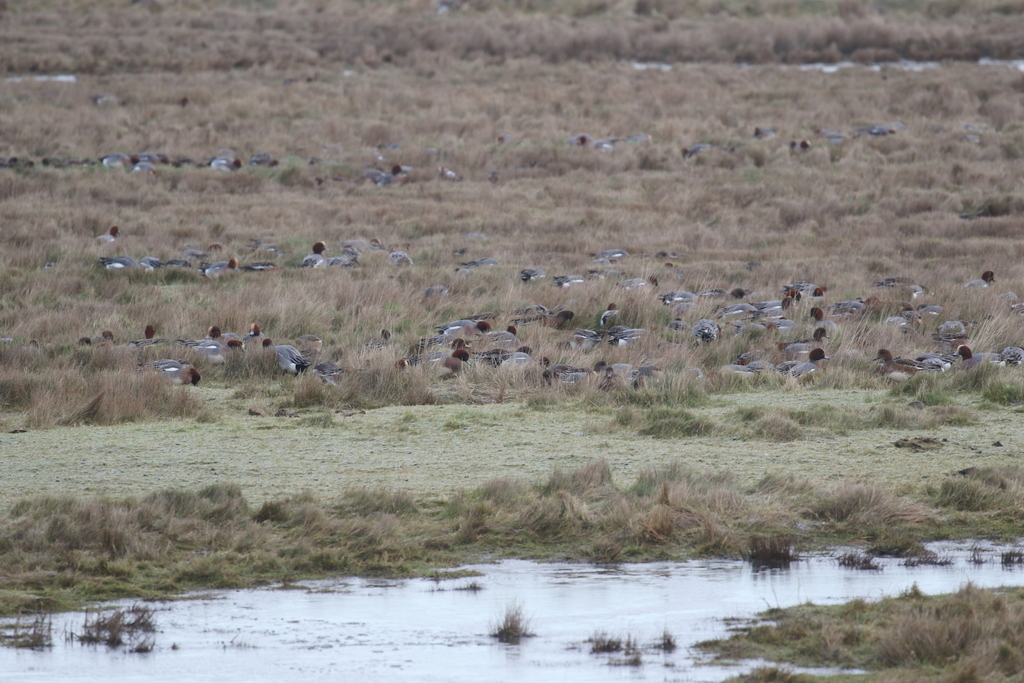
A Marsh Harrier flew in over the grazing marshes, a female, mostly chocolate brown but with a pale creamy head, pale leading edge to the wing and a pale crescent on her breast. It spooked all the Wigeon and they flew up, whistling, and landed down on the open water on the Serpentine.
We flushed a small flock of Linnets and a single Meadow Pipit from the bank just before the main drain, from where they were feeding in the grass below the edge of the reeds. Looking out along the drain, we could see a Little Grebe towards the back. Another surfaced, and then another, until there were 5 Little Grebes all out on the water. Some movement down at the front then caught our eye, and we looked down to see a Water Rail swimming across the channel. It disappeared straight into the long grass on the far bank.
Continuing straight out to the beach, there was no sign at first of the juvenile Glaucous Gull which had been here for several days now. It has been feeding on several dead seals which have washed up on the beach, but we couldn’t see it next to any of them now. Then someone walking back up the beach told us it was currently down on the shoreline, so we walked over the shingle to where we could see the water’s edge.
Sure enough, the Glaucous Gull was down on the edge of the beach. We watched it in the scope, walking in front of where the waves were breaking and seemingly picking things up from the stones. It had been rather stormy here yesterday, and there was probably a lot of things to eat washed up as a consequence. Through the scope, we could see its distinctive pale wingtips and its huge bill, pale pink with a ‘dipped-in-ink’ black tip.
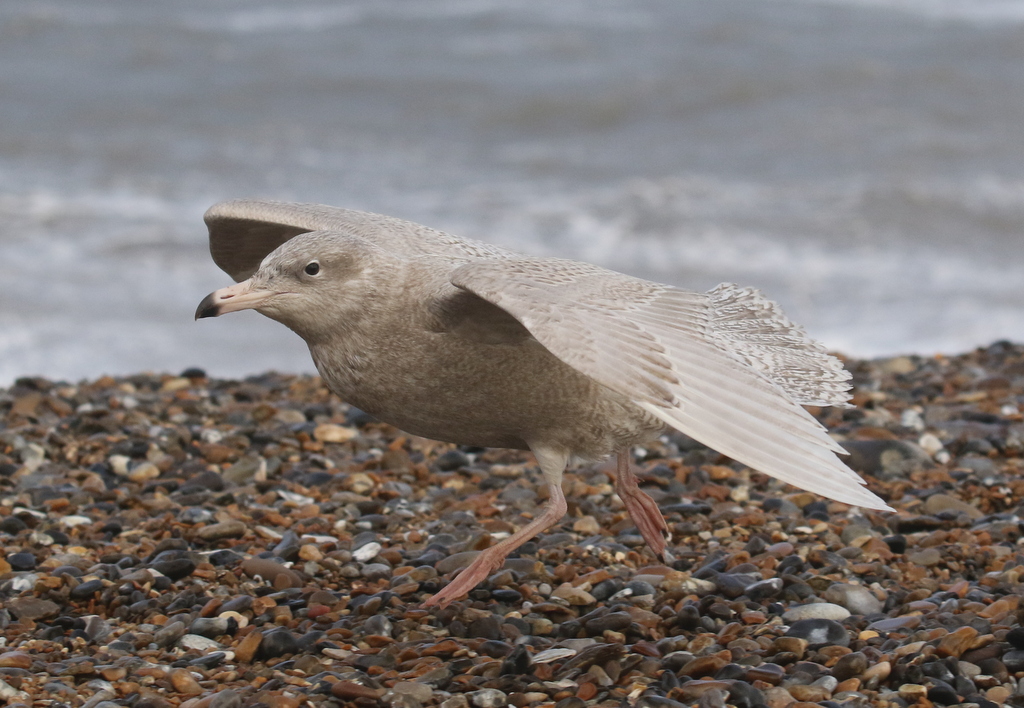
The Glaucous Gull spotted a raucous gathering of more gulls further up the beach, hovering over the breakers. It took off, giving us a good look at its pale primaries, and flew over to join them. It obviously didn’t find anything there to its liking, as it then continued further on and landed out on the sea.
There has been a flock of Snow Buntings along the beach here in recent days, so we walked up towards the beach car park at Cley to look for them. Three Pintail were fast asleep on one of the islands on North Scrape, as we passed. They didn’t even wake up when a large flock of noisy Brent Geese flew in and landed all around them. But when we got to the weedy vegetation on the top of the beach where the Snow Buntings have often been feeding, there was no sign of them. There was a large flock of Goldfinches here, and periodically several Skylarks would fly up out of the longer grass.
We stopped to watch the Glaucous Gull again for a few minutes. It flew in off the sea, hovered over the shoreline and dropped down to pick something up off beach, then flew back out to the water. It had obviously had enough of eating dead seal for the last few days, and was enjoying a bot of variety in its diet this morning. Two Guillemots flew west close inshore, but we couldn’t see much else out on the water today.
We decided to walk back to the East Bank. A Little Egret was feeding on the brackish pools by the path as we passed. We watched it trying to disturb fish by jiggling its foot in the mud ahead of it, looking to see if anything came out.
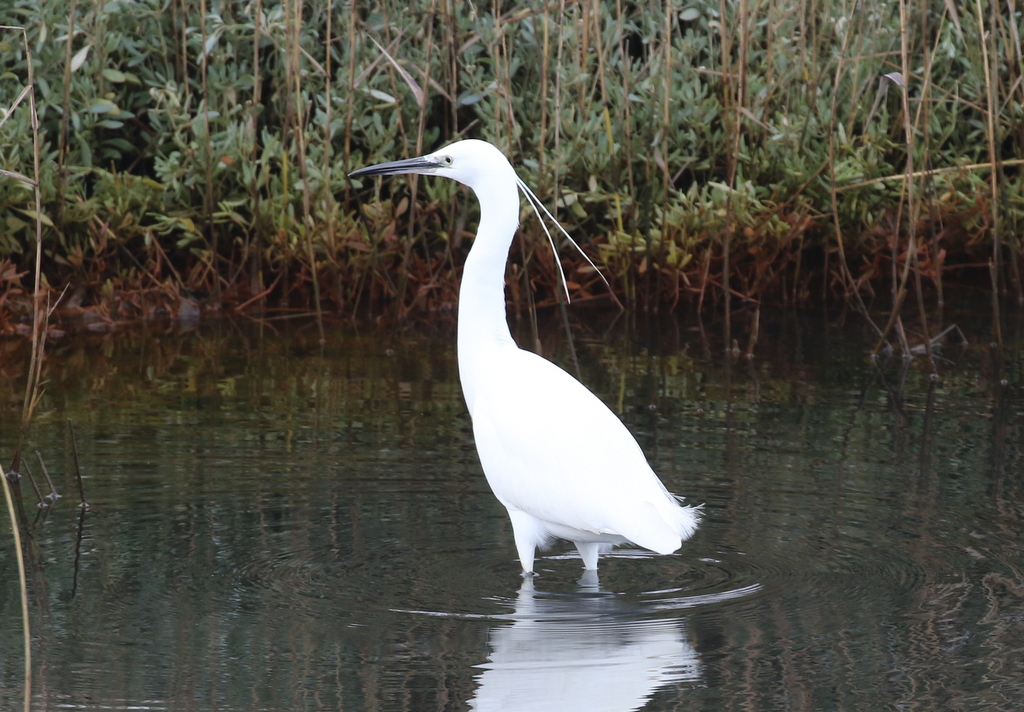
From the shelter on the East Bank, we could see a selection of waders out on Arnold’s Marsh. A small group of Black-tailed Godwits were standing in the shallow water over on one side. There were several Curlews and Redshank scattered around and a single Turnstone on the stony island at the back. We could also see some Gadwall right over in the back corner, but they were too far away to appreciate from here.
Someone very kindly came in to tell us that the Snow Buntings had reappeared, just at the top of the East Bank. We walked back up to the beach, but there was no sign of them there again. Apparently they had flown off east. At that point a Marsh Harrier came over from the direction of Sea Pool towards the back corner of Arnold’s and we saw the Snow Buntings fly up from the shingle. We walked down that way for a closer look.
There was a large flock of Snow Buntings here, at least 50 birds today. They were very skittish, and kept flying round, in a flurry of white wings. After coming up and landing again a couple of times on the shingle beyond the fence, they flew straight towards us, and landed much closer on the bottom of the old shingle ridge. We had a great view of them here, but they didn’t stop long. Suddenly they were off again, over the ridge towards the beach, then back and off east over Sea Pool.

We were much closer to the Gadwall now, so we trained the scope on a sleeping drake. From here we could really appreciate the intricacy of its plumage, not just plain old grey but a variety of different patterns, barred and scalloped. The connoisseurs’ duck!
Avocet was a target for the day, so we headed back to the Visitor Centre and walked out to Bishop Hide. The scrape was still partly frozen, and there didn’t seem to be much to see out here today. But we did find five Avocets asleep in the water in front of one of the small islands, so our mission was accomplished. A few Lapwings and Black-tailed Godwits were on the mud behind.
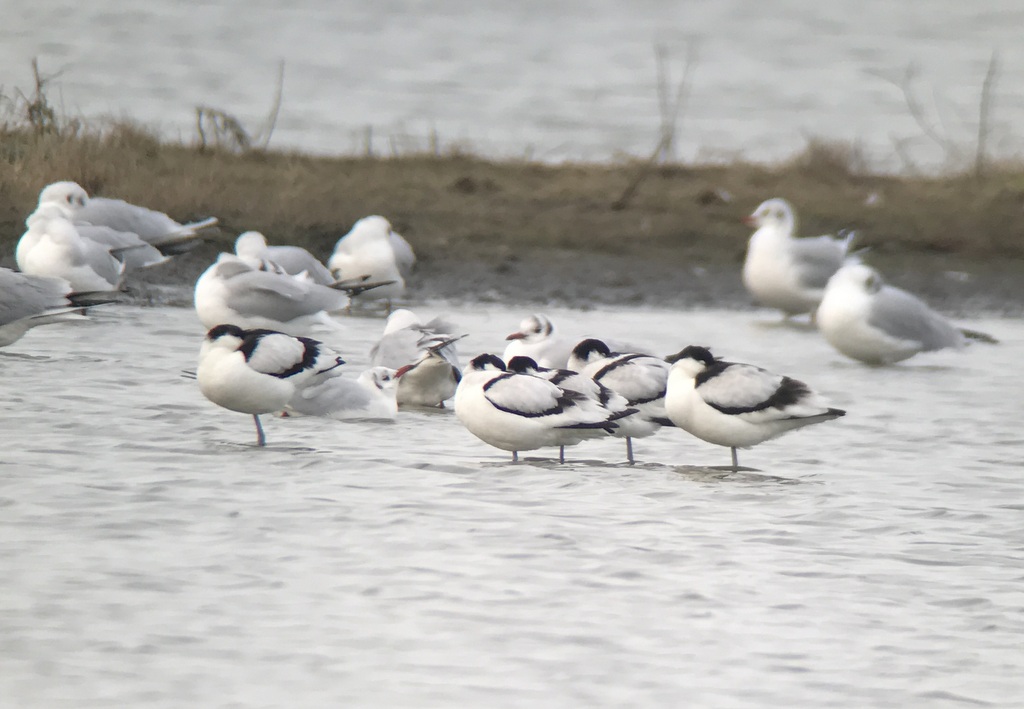
Holkham was our destination for the afternoon. As we drove up along Lady Anne’s Drive, we could see lots of Wigeon out on the grazing marsh to the west. A big flock of Brent Geese was feeding on the grass the other side, but they were rather more distant today.
It was time for lunch, so we called in at ‘The Lookout’ café for a welcome hot drink. Looking through the wooden slats, we could just see lots of Pink-footed Geese covering the grazing marshes beyond, although it was a better view of them from outside, without having to look through the slats.
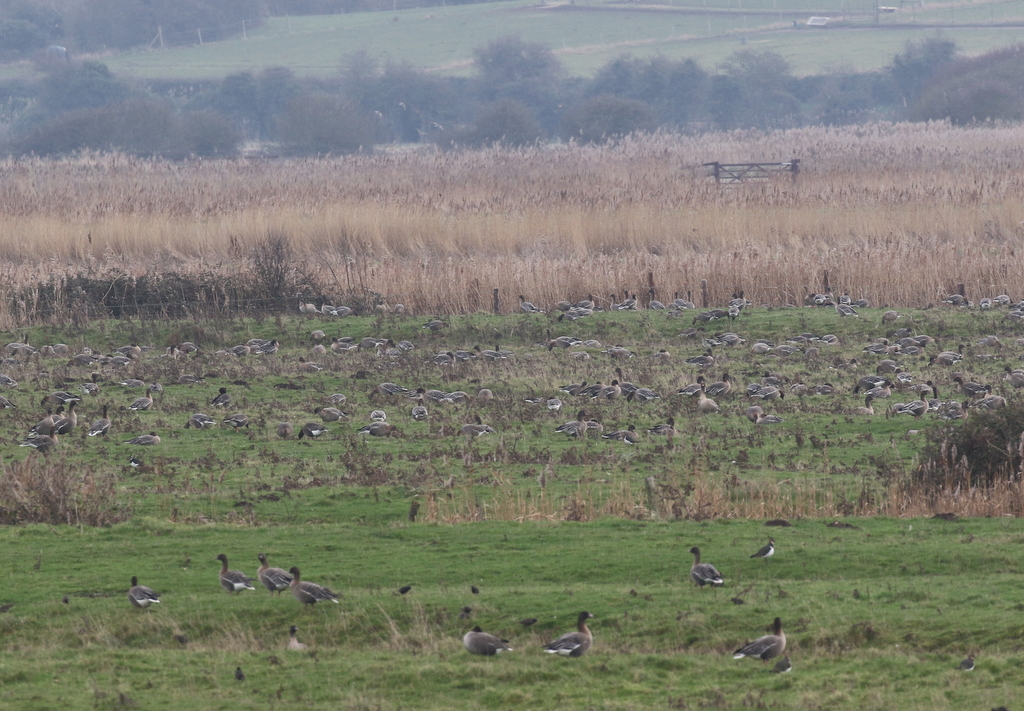
After lunch, we popped quickly back to the car to get the scope and drop off our bags. On our way, we noticed several Grey Partridges out on the grazing marsh, quite close to the edge, so we stopped for a closer look. We could see their orange faces, very different from the black-and-white pattern on a Red-legged Partridge.
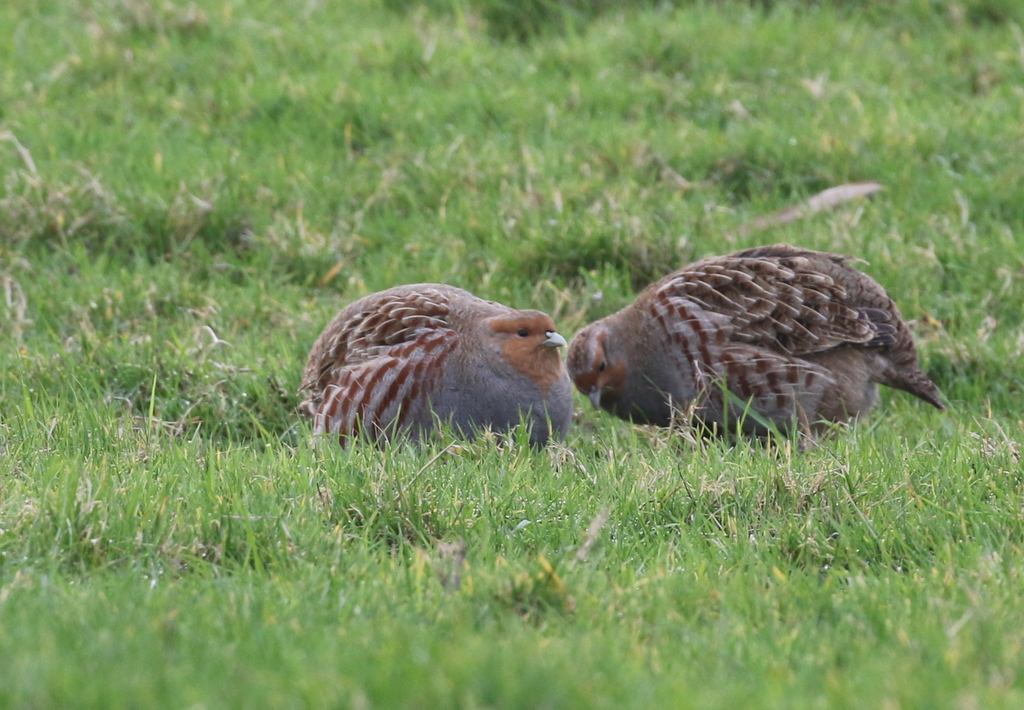
We made our way out towards the beach next, through the pines and then east on the path on the edge of the saltmarsh. A flock of Linnets flew up in front of the dunes, and bounced around as if they were attached to something by elastic.
We could see some people further over, by the cordon, looking through their scopes. We hadn’t got to them when the Shorelarks took off, flew past us low over the saltmarsh and disappeared off west. We watched them almost to the Gap, when thankfully they turned and flew back, landing back over just before the path to the beach before the cordon.
When we got over to the beach path, we quickly found the Shorelarks out on the saltmarsh. They were tricky to see though, hidden down in the taller vegetation here. Eventually we got a good look at them as they came out into some slightly shorter grass.
When we heard Long-tailed Tits calling from over towards the pines, we looked over to see birds moving about in the buckthorn in the low dunes in front of the trees. We could see the tits moving through further back, but then we noticed a female Stonechat perched on one of the bushes. Looking through the scope, one of the group saw a small bird moving in the buckthorn below it. It was grey and brown, a Dunnock perhaps? Then they said it had a long tail – it couldn’t be, could it? Then suddenly a Dartford Warbler hopped out right beside the Stonechat.
This is not an area where you would routinely expect to find a Dartford Warbler. However, the young ones disperse from the heaths on which they breed and can then very rarely be found along the coast. They often follow Stonechats around on heaths, so that was what this Dartford Warbler was now doing here instead. A great bird to find here.
We watched the Dartford Warbler for a while. It kept disappearing down into the buckthorn and we lost sight of it, but if we followed the Stonechat then the Dartford Warbler would eventually appear in the bush underneath it again. Eventually everyone got a good look at it and by the end a few other people had joined us to watch it too.
In the meantime, while we had been looking the other way, the Shorelarks had worked their way through the saltmarsh straight towards us. We turned round to see they were now very close, just behind us. We didn’t know which way to look – Dartford Warbler or Shorelarks, a very rare choice to have to make! The Shorelarks don’t often come quite so close here – they were possibly affronted that we were paying them so little attention! So we had to tear ourselves away from watching the Dartford Warbler and make sure we admired the Shorelarks too.
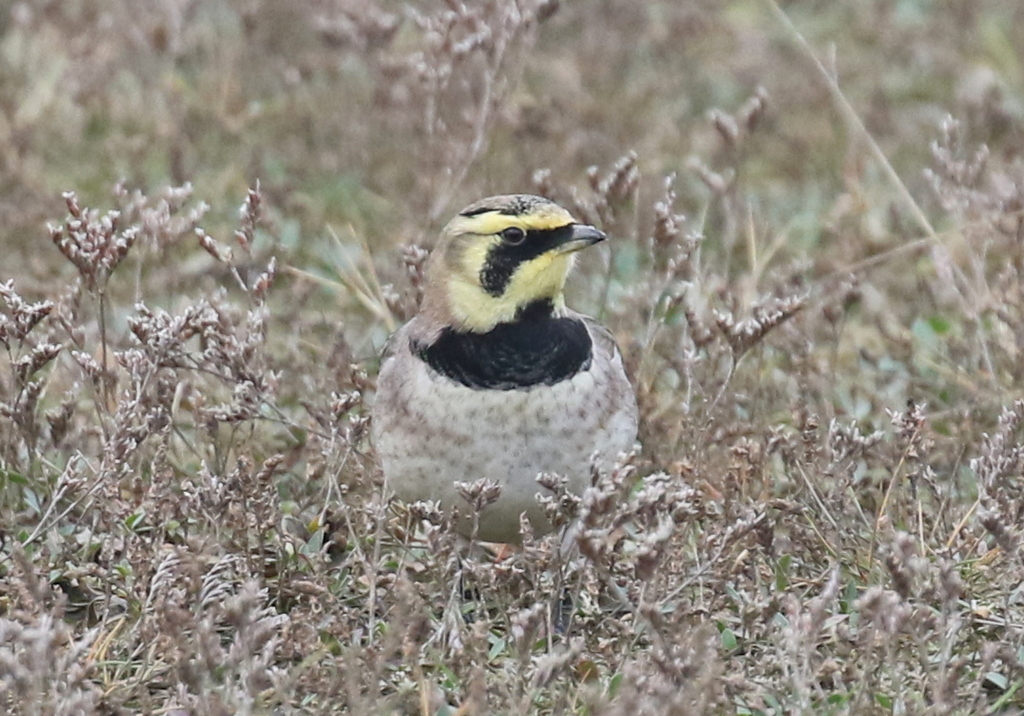
Eventually we lost sight of the Dartford Warbler and the Shorelarks went back further out on the saltmarsh again. We decided to continue on out to the beach. As we got through the dunes, we could see a large flock of ducks just offshore. They were not seaducks though, but Wigeon, presumably disturbed from the grazing marshes and seeking sanctuary out here temporarily. The sea looked fairly calm, but there was a surprisingly big swell here, and they kept disappearing from view.
We had been told that a Red-necked Grebe had been offshore earlier, and it suddenly appeared just behind the flock of Wigeon. Otherwise, there was not much offshore here today – a few Cormorants flying back and forth, a couple of small groups of Common Scoter past and a Red-throated Diver which flew off west. The tide was in, but there were still a few Oystercatchers on the beach.
It had been a very successful walk out to the Bay, so we made our way back to the car. Time was getting on now, but we had a quick look out at the grazing marshes at the other side of Holkham. The first thing we noticed as a large white shape over in the far corner. It was a Great White Egret and through the scope we could see its long, yellow, dagger-like bill.
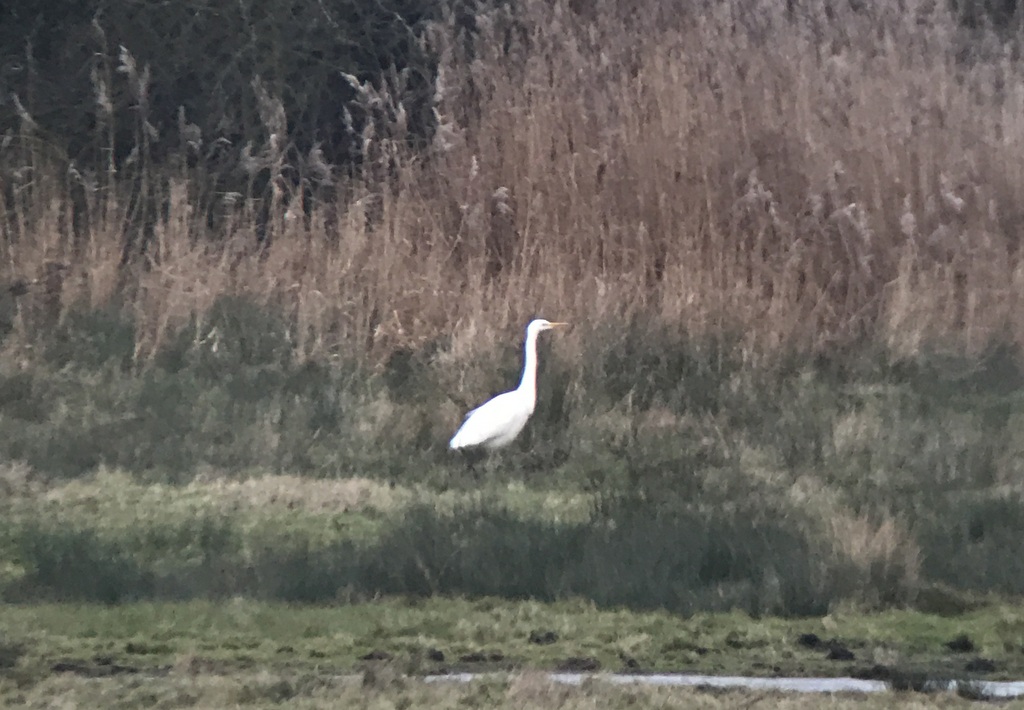
There were some Greylag Geese over by the Great White Egret. Big and rather pale grey, we could see their large, orange carrot-like bills. As we scanned across the grazing marsh, we then spotted lots of White-fronted Geese too. Much smaller and darker than the Greylags, we could see the white surround to the base of their bills, from which they get their name, and the distinctive black belly bars on the adults.
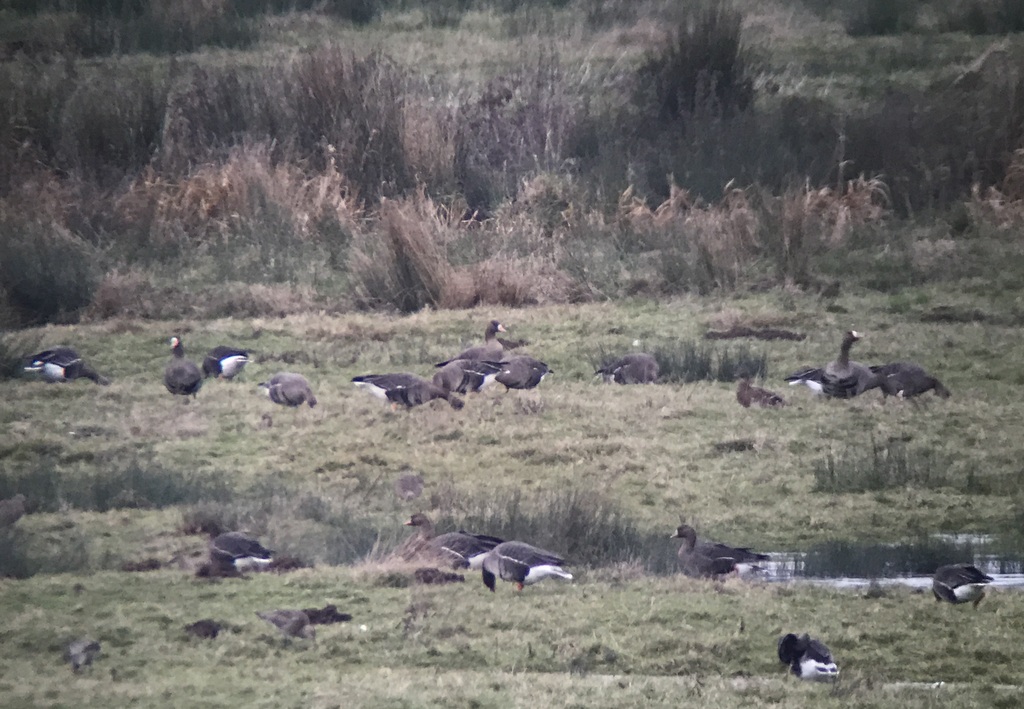
Further round still, we spotted yet another Great White Egret, half hidden through the trees in front of us.
It was getting late now, and the light was already starting to go. By the time we got to Stiffkey, we thought we might have missed the Hen Harriers coming in to roost. But when we arrived we were told there had not been much activity so far tonight – it seemed like they were late coming in, possibly making the best of a good evening for some late hunting, particularly after the sleet and snow showers yesterday afternoon.
We stood and scanned for a while. Lots of Little Egrets flew past, heading off to roost, and we could hear the plaintive calls of Curlews out on the saltmarsh. A very distant Hen Harrier, a ringtail, did fly in away to the west but it was impossible to see in the gathering gloom, low against the dark vegetation.
Looking west as the light faded, a huge flock of several thousand Pink-footed Geese came in from the fields, and headed out across the saltmarsh, dropping down to roost on the flats beyond. It was quite a sight, one of the real sights of a day birding on the North Norfolk coast in the winter, and a nice way to end the day.
















